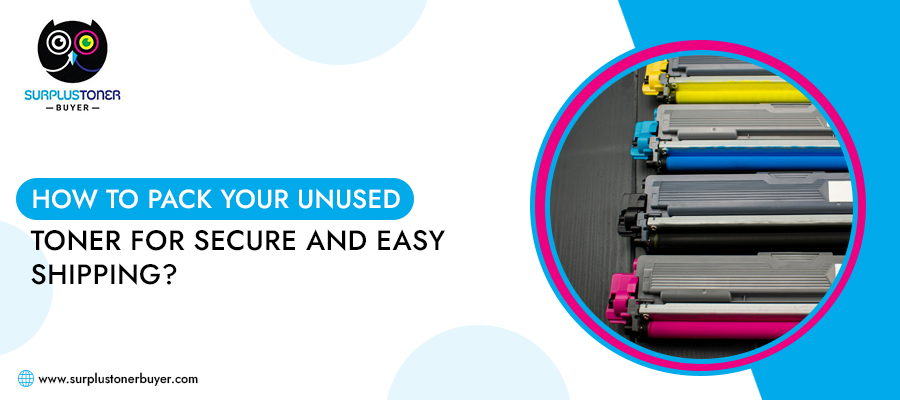
If you’ve ever tried shipping an ink or toner cartridge and worried about it leaking, getting damaged, or rejected by the receiver, we got you. Selling and Shipping unused toner sounds easy enough—a small, lightweight item shouldn’t cause much trouble, right? But in reality, these cartridges are surprisingly delicate and can cause quite a mess (or a shipping delay) if they’re not packaged correctly. Whether you’re selling to another business, returning unused stock, or sending extra toner to a new office, knowing how to ship printer ink or toner safely makes all the difference.
Here’s a friendly, step-by-step guide to help you pack toner for shipping the right way—so it stays protected, your shipment arrives clean, and you save time, money, and stress.
Step 1: Gather the Right Materials
Before you start, make sure you have the proper supplies. Having these ready ensures the process goes smoothly:
-
Sturdy shipping box or Pallet:
Pick one that’s slightly larger than your toner box to allow for padding. Reinforced or double-walled boxes are best for multiple cartridges.
-
Original packaging:
If you use the toner’s factory box, you’ll protect the cartridge perfectly, as it’s designed to do so.
-
Plastic bags or sealed pouches:
These act as an extra layer to contain any leakage. Heavy-duty ziplock bags work great.
-
Bubble wrap or packing paper:
For cushioning and to fill empty spaces. Avoid newspapers as it may transfer ink.
-
Packing tape:
Use quality tape to seal the box tightly.
-
Shipping labels:
Clearly mark your package so it gets handled correctly.
If you plan to ship several toners, you may also want a divider insert or cardboard spacers to keep them from touching one another.
Step 2: Keep Your Toner in Its Original Box if Possible

If your toner cartridge is unused and still sealed in its retail box, you’re already halfway there. Manufacturers design these boxes to hold cartridges snugly, often with foam or plastic supports that keep them from moving.
Simply place each original box into a shipping carton or pallet. If you’re wondering how to ship printer ink or toner when you don’t have the original box, don’t worry. You can still do it safely with a few extra steps, outlined next.
Step 3: Double Bag for Protection
If the original box is missing, wrap the toner cartridge itself in plastic to prevent leaks. A strong, resealable plastic bag works fine, but for best results:
- Wrap the cartridge in bubble wrap first to protect it from impact.
- If you’re shipping multiple cartridges, bag each one individually.
This double layer helps protect both the item and the rest of your shipment.
Step 4: Cushion Everything Inside the Box
Your goal here is to keep the cartridges from moving around inside the box. To prevent that, line the bottom of your box with 2–3 inches of bubble wrap or packing paper. Place the wrapped toner cartridges upright (print head facing up). Fill in all the extra space around them with more bubble wrap or paper until everything is snug.
Give the box a gentle shake—if you feel movement, add more filler. There should be zero internal shifting when the box is moved or turned.
Step 5: Seal it Securely
Close the flaps of your box and seal them using the “H-taping” method: one strip of tape down the center seam and two across the sides. This keeps the box tightly sealed even if bumped during shipping. If you ship several boxes, mark each one clearly as part of a set (“1 of 3,” “2 of 3,” etc.) to ensure they all arrive.
It’s also a good idea to mark the package with “FRAGILE”, “HANDLE WITH CARE”, or “THIS SIDE UP”—even though toner isn’t technically breakable, these labels encourage more careful handling.
Step 6: Keep Temperature in Mind
Toner cartridges are sensitive to extreme heat and cold. If you’re selling and shipping unused toner across long distances or during hot summer months, try to avoid leaving it in a vehicle or warehouse for extended periods. Temperature fluctuations can cause the toner powder to clump or affect cartridge seals. Know the risks of improper and long-term storage of toners and inks.
When possible, schedule the shipment early in the week—Monday through Wednesday—so it doesn’t sit in a delivery truck or sorting facility over the weekend.
Step 7: Choose the Right Carrier and Service
Most major carriers accept toner shipments, but they have specific rules for handling them. It’s smart to check their guidelines if you’re sending a large quantity. Business accounts sometimes offer better protection and insurance options for delicate items like printer supplies. It’s inexpensive coverage that protects you in case of loss.
Final Thoughts
Shipping toner doesn’t have to be stressful or messy—as long as you take a little extra time to pack it right. Using sturdy boxes and pallets, sealing everything well, and paying attention to temperature and labeling can prevent leaks, damage, and shipping headaches.
So next time you’re getting ready to sell unused toner, grab a little bubble wrap, a solid box, and some extra tape. With the right preparation, your toner will arrive just as pristine as when you packed it—no spills, no stress, just smooth shipping every time. If you’ve still got any questions, reach out to the experts by calling 855-418-6637 or drop us a message here.
